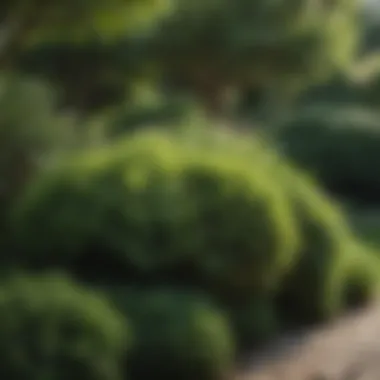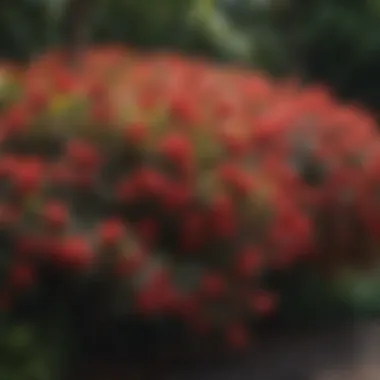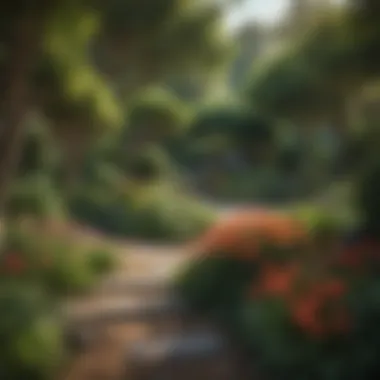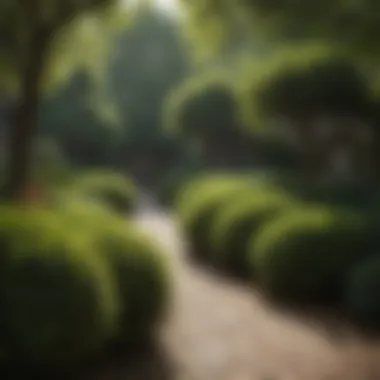Exploring Full Shade Tolerant Shrubs for Gardens


Intro
In the world of landscaping, creating a beautiful garden in shaded areas can seem like a daunting task. However, full shade tolerant shrubs offer an intriguing solution. These plants not only thrive in low-light conditions but can also introduce texture and color to otherwise drab spaces. Understanding how to effectively utilize these shrubs enhances garden aesthetics and allows for more diverse planting.
This article aims to explore the multifaceted potential of full shade tolerant shrubs within garden design. It examines various species that flourish in full shade, discusses their advantages, and provides practical advice on care and maintenance. The objective is to equip homeowners and gardening enthusiasts with valuable insights for transforming shadowy spots into vibrant, inviting landscapes.
Among the key points we will touch on are different design inspirations suitable for shaded gardens. Additionally, we will look into gardening advice, including seasonal planting tips and maintenance guidelines. Together, these elements will create a holistic understanding of how to maximize the potential of shaded areas using shrubs that naturally thrive where sunlight is scarce.
Understanding Shade Conditions
Understanding the various shade conditions is crucial for effective garden design, especially when considering shade tolerant shrubs. Many gardeners encounter areas where sunlight is limited, due to structures, trees, or geographical obstacles. These shaded environments present unique challenges and opportunities. To foster a thriving garden, one must appreciate the diversity of shade types and their effects on plant growth. This section delves into the different types of shade and their implications on garden aesthetics and health.
Types of Shade
Full shade
Full shade occurs in areas where direct sunlight does not penetrate at all. This condition often exists under dense tree canopies or in north-facing gardens. The main characteristic of full shade is that there is little to no light for at least six hours a day. This presents significant challenges for many plants that rely on sunlight for growth. However, full shade also provides a niche for specially adapted shrubs that thrive in such conditions. Their resilience allows landscapers to incorporate greenery in otherwise stark areas. Plants like ferns and certain azaleas are notable examples that flourish in these conditions. The advantage is that they fill spaces that would otherwise remain bare.
Partial shade
Partial shade refers to areas that receive filtered light for part of the day, often for about three to six hours. This pattern usually occurs beneath taller trees or in spots where sunlight is intermittently blocked. The ability of plants to adapt to partial shade makes it a more flexible condition compared to full shade. Many shrubs can tolerate various lighting conditions and adapt to partial shade, making them a versatile choice for many gardens. The unique feature of partial shade is its potential for a wider range of plant options, allowing for seasonal interest and textural variety. However, gardeners must monitor these areas closely, as competition for moisture can become an issue.
Dappled shade
Dappled shade is characterized by patches of light and shadow created by leaves filtering sunlight. This often occurs beneath trees with leaves that are sparse or in areas where light is partially blocked but still reaches the ground. The key characteristic of dappled shade is that it allows some sunlight to nourish the plants while providing enough shelter from harsh midday sun. This balance can create an environment where certain shrubs thrive, offering rich textures and colors to the landscape. Dappled shade allows for more plant diversity compared to full or partial shade, but like the other types, careful selection of species is important to maximize health and aesthetics.
Impact of Shade on Plant Growth
Shade conditions have profound effects on plant growth, influencing their health, form, and ability to thrive. Shade shapes the ecosystem by altering various growth factors.
Photosynthesis limitations
One of the most notable impacts of shaded environments is the limitation on photosynthesis. While all plants require sunlight for this process, those in full shade must rely on lower light levels. The specific aspect of these limitations is that photosynthesis can be significantly reduced, potentially affecting plant vigor and growth rates. Shade tolerant shrubs possess adaptations that allow them to capture the available light more efficiently. However, understanding the limits of photosynthesis in these conditions is vital to selecting appropriate species. The main advantage of selecting internet shrub choices is their performance in lower light while preserving their aesthetics.
Soil moisture retention
Shade greatly influences soil moisture levels, a critical factor for plant health. Moisture often remains higher in shaded areas due to reduced evaporation. This can benefit plants that prefer consistent wetness, such as certain ferns. The unique feature of soil moisture retention means that shade gardens can be less demanding when it comes to watering schedules. However, it also means gardeners must cautious of overwatering, as shaded conditions can lead to waterlogged soil that may cause root rot.
Temperature variations
Finally, shade conditions affect temperature, creating cooler environments under tree canopies. The specific aspect of temperature variations is that shaded gardens often experience less fluctuation than sunnier areas. This can provide a more stable environment for sensitive plants. A benefit is that this stability can protect plants from heat stress. However, understanding the dynamics of temperature can be intricate; gardeners must consider how surrounding structures and foliage interact with light and heat.
Understanding shade conditions is essential for creating effective garden designs, especially in light-restricted areas.
Why Choose Shade Tolerant Shrubs?
Shade tolerant shrubs are essential for any gardener aiming to maximize their landscape potential. These plants effectively fill areas that receive minimal sunlight while providing numerous practical benefits. Utilizing such shrubs allows homeowners to enhance the aesthetics of their gardens, contributing to a more vibrant and diverse ecosystem. Moreover, they can serve functional purposes, including soil stabilization and providing habitat for various species. Choosing these shrubs helps create a commitment to sustainability in landscape design.
Aesthetic Appeal
Maintaining lush greenery
Maintaining lush greenery in shaded areas is a primary advantage of using shade tolerant shrubs. The rich foliage of these plants contrasts with the surrounding environment, bringing life to otherwise dull spaces. The key characteristic of lush greenery is its ability to thrive with limited light, allowing the garden to flourish all year round. This persistence is a beneficial choice because it provides color and depth to landscapes that would otherwise be barren.


Unique features include the varying shades of green found in different species, each offering its own texture and form, thus making it appealing even in the shade. However, gardeners need to ensure proper spacing and care since overcrowding can diminish the lush factor.
Seasonal interest
Seasonal interest is another fundamental trait of shade tolerant shrubs. Many species produce vibrant blooms or unique foliage changes throughout the seasons, adding dynamic beauty to a shaded garden. This characteristic makes these shrubs a popular choice for creating interest even when sunlight is scarce. For instance, some shrubs might bloom in early spring while others take center stage in autumn with colorful foliage.
A unique feature of this aspect includes the evergreen varieties that maintain visual interest in the winter months. While seasonal changes add charm, it is crucial to select a mix of species that can complement each other throughout the year to maximize the visual impact of the garden.
Environmental Benefits
Improving soil health
Improving soil health is a significant benefit derived from the presence of shade tolerant shrubs. These plants contribute to the soil structure, preventing erosion and enhancing nutrient retention. They help in maintaining moisture levels, which is crucial in shaded gardens where soil can remain wetter. The roots of these shrubs create pathways for air and water, fostering a healthier ecosystem. This advantage is particularly relevant since healthy soil promotes the overall vitality of the garden.
Another unique feature relates to the organic matter produced by these plants. When leaves fall and decompose, they enrich the soil, offering natural fertilization throughout the seasons. However, some shrubs may require specific conditions to thrive, necessitating careful selection and placement.
Supporting local wildlife
Supporting local wildlife is a vital function of shade tolerant shrubs. These plants create habitats for various birds, insects, and small mammals, directly contributing to biodiversity in the garden. The presence of a variety of shrubs encourages pollinators, which are essential for the health of many flowering plants.
The key characteristic of wildlife-supporting shrubs is their ability to provide shelter and food sources. Certain species produce berries or seeds that attract various creatures. This feature greatly benefits ecosystems and gardeners alike, fostering natural pest control and pollination. However, it is essential to offer a diverse selection to ensure that a wide range of wildlife is supported throughout the year.
"Incorporating shade tolerant shrubs not only beautifies the garden but also plays a crucial role in sustaining local ecosystems."
Identifying Suitable Shrub Species
Identifying suitable shrub species is essential for creating a successful garden design, especially in areas with full shade. The types of shrubs chosen can greatly impact the garden's overall aesthetic and ecological health. This section provides insight into selecting shrub species that thrive under low light, addressing both native and non-native options. Proper selection ensures that the plants established will perform well in shaded environments, leading to a more vibrant and healthy landscape.
Native vs. Non-native Shrubs
Benefits of native species
Native shrubs play a crucial role in promoting biodiversity. They are well-adapted to the local climate and soil conditions. This adaptability often means less maintenance and better survival rates. Native species support local wildlife, providing food and habitat for birds, insects, and other animals. Their deep root systems also help in soil stabilization and water retention. In this article, we focus on how native species contribute positively to the garden ecosystem, making them a beneficial choice. Understanding their adaptability allows gardeners to maintain greener spaces with fewer resources.
Considerations for non-native introductions
Non-native shrubs can offer unique aesthetic qualities and sometimes even different flowering times. However, it is vital to approach their introduction carefully. In some cases, non-native species may become invasive, outcompeting local flora. Consider habitat compatibility, climate resilience, and potential benefits when selecting non-native options. These plants may offer visual variety but could disrupt ecological balance if not monitored properly. Weighing these advantages and disadvantages is key to making informed choices in garden design.
Popular Shade Tolerant Shrubs
Azaleas
Azaleas are well-known for their striking blooms and ability to tolerate shade. They come in a variety of colors and shapes, allowing flexibility in design. Their vibrant flowers add seasonal interest to shaded areas, making them an essential choice for gardeners looking to brighten up dim spots. Azaleas excel in acidic soils and prefer a moist environment. Over time, they may require specific maintenance to encourage blooming and prevent diseases. Overall, they are a popular choice due to both their beauty and adaptability.
Boxwoods
Boxwoods are valued for their evergreen foliage, providing consistent structure year-round. They are versatile in landscaping, suitable for hedges or standalone specimens. Their dense growth habit offers great privacy, which is useful in shaded areas where other plants may struggle. Boxwoods thrive in moist, well-drained soil, but care must be taken to avoid overwatering. They are a beneficial species for creating a lush green backdrop, especially in more formal garden designs.
Ferns
Ferns offer an elegant appearance with their delicate fronds. They thrive in moist, shaded conditions, making them ideal for full shade gardens. Ferns provide texture and movement, contrasting well with the sturdier aspects of shrubs. They can thrive in various soil types and temperatures, but they do prefer consistently damp environments. Their unique feature lies in the varied textural qualities, which can enhance the visual appeal of shaded landscapes. With many species available, there's a fern for nearly every shaded situation.
Less Common Options
Winterberry


Winterberry is a deciduous holly that produces bright red berries in fall and winter. These berries serve as excellent wildlife food sources, attracting birds to the garden. It thrives in wet soils and does best in full to partial shade. The striking visual of the berries against barren winter branches provides seasonal interest. However, it requires a male plant for pollination to produce fruits, which is a consideration when planting. Consequently, this shrub is a unique addition that supports biodiversity.
Sumac
Sumac is another less common option that can thrive in shaded spaces. It offers beautiful autumn colors, turning bright red and orange, which can brighten low-light garden areas. They prefer well-drained soils and can handle drought conditions once established. One must be cautious, as some types can spread aggressively, potentially becoming invasive if not properly managed. Therefore, it remains a good choice for gardeners willing to monitor growth closely.
Japanese holly
Japanese holly is an evergreen shrub that adds year-round color and shape to shaded gardens. It offers small, glossy leaves and a dense growth habit. This plant is used frequently in landscaping for formal and informal designs. While it can adapt to various soil types, it prefers well-drained soil and thrives in shade. However, gardeners should note that certain varieties may not be as hardy in cold climates. Overall, Japanese holly remains a valuable option for those looking to maintain greenery in darker areas.
Design Principles for Shade Gardens
Designing a garden in shady areas requires a thoughtful approach. Full shade tolerant shrubs offer a solution to enhance the beauty and functionality of these spaces. It is essential to understand design principles that can maximize the potential of these plants. Key aspects include layering, color selection, and texture variation. Each element plays a critical role in transforming a shadowy garden into a vibrant, inviting area.
Applying these principles can help in overcoming the challenges posed by low light. Additionally, a well-designed shade garden can contribute positively to the overall landscape, creating balance and harmony.
Creating Layers
Utilizing height variations
Utilizing height variations is a fundamental technique in creating visual interest in a shade garden. By incorporating shrubs of different heights, it adds depth and dimension. This characteristic allows for an organized arrangement where taller plants can backdrop shorter ones. It is an effective choice that prevents flatness in design.
One advantage is the ability to ensure that lower plants receive adequate light. Taller shrubs can also serve as a windbreak, providing shelter for more delicate species. However, one must also consider the maintenance requirements of taller varieties. They may need more pruning to maintain an attractive shape.
Combining shrubs with perennials
Combining shrubs with perennials enhances the garden’s complexity and appeal. This practice creates overlapping bloom periods, allowing for continuous interest. The key characteristic of this combination is the dynamic interplay of contrasting plants. It is a beneficial choice, as it provides structure and flexibility in the design.
The unique feature of this approach lies in its adaptability. Seasonal changes can highlight different elements, resulting in a lively environment year-round. However, careful selection is required, as some perennials may compete for resources with shrubs.
Color and Texture Considerations
Choosing a color palette
Choosing a color palette for a shade garden is crucial for creating mood and harmony. Lush greens can be soothing, while brighter hues offer pops of attraction. This aspect creates focal points that draw the eye. It is a beneficial choice for maintaining visual interest in low light conditions.
A well-selected color palette can also unify diverse plant species, making the garden appear cohesive. However, overuse of bold colors can lead to visual clutter, so balance is essential. Choosing shades that complement one another while allowing some contrast can elevate the garden’s overall aesthetics.
Variability in foliage texture
Variability in foliage texture is an important aspect of garden design. Different textures can create layers of intrigue, capturing the viewer’s attention. This characteristic encourages the eye to explore and notice subtle differences. It is popular in shade gardens as it compensates for limited flowering options in low light.
A mix of smooth, coarse, and glossy leaves can produce an engaging visual experience. This contrast can also enhance plant health by reducing pest problems through diversity. Nevertheless, careful planning is needed to ensure that textures work well together, avoiding a disjointed look.
Maintenance and Care
Maintaining full shade tolerant shrubs requires specific knowledge and attention. These plants, while often resilient, need proper care to thrive. Good maintenance ensures that the shrubs not only survive but also enhance the garden's aesthetic appeal. It involves a blend of understanding watering needs, pruning strategies, and recognizing signs of stress. Care practices can significantly improve growth and visual impact in shaded environments.
Watering Requirements
Understanding moisture needs
Understanding moisture needs is essential for the health of shade tolerant shrubs. These plants can differ significantly from sun-loving varieties. They tend to prefer consistent moisture levels, especially during dry periods. Lack of adequate water can lead to wilting or stunted growth.
One key characteristic of these shrubs is their root systems, which may require a specific balance of moisture. Overly dry soil can cause roots to shrink and limit nutrient uptake. Choosing a well-draining soil mix helps retain moisture without risking root rot.


Also, it is common that plants in shady areas have different moisture retention capabilities due to the reduced sunlight. This can be both an advantage and a challenge. Properly managing water is necessary to prevent issues related to drought stress.
Signs of overwatering
Recognizing signs of overwatering is as crucial as understanding moisture needs. Surprisingly, even shade tolerant shrubs can suffer when water levels are too high. Waterlogged soil can lead to root diseases, which can ultimately kill the plant. Symptoms include yellowing leaves, wilting, and a general appearance of distress.
A beneficial approach to watering is observing the soil texture. Moist soil should feel cool and slightly damp. If it feels muddy and has an unpleasant smell, it is a strong indication of overwatering. Plants may need less frequent watering if the surrounding area remains consistently humid.
Pruning and Trimming
Best practices for maintaining shape
Maintaining the shape of full shade tolerant shrubs requires strategic pruning. Regular trimming helps promote healthy growth and an appealing form. Best practices include cutting back dead or diseased branches, which can prevent the spread of pests and diseases.
It is recommended to use clean tools to avoid transmitting pathogens. Pruning at the right time enhances fruit and flower production, and it opens up the canopy for better air circulation. A well-maintained shrub contributes to a balanced visual composition within the garden.
Timing and methods
Understanding the timing and methods of pruning is vital to shrub health. The best time to prune these shrubs varies depending on the species. Generally, late winter or early spring is ideal for many types. This timing promotes growth as they enter their active growth phase.
Different methods, such as thinning cuts or heading cuts, can have various effects. Thinning cuts remove whole branches and improve light penetration, while heading cuts shorten stems to promote bushier growth. Choosing the right method ensures that the shrubs will flourish in a full shade environment.
"Regular maintenance is key to ensuring full shade tolerant shrubs not only survive, but thrive."
Common Challenges
Incorporating full shade tolerant shrubs into any garden poses unique obstacles. Understanding these challenges is essential for successful garden management. Addressing such issues ensures that your shrubs thrive and contribute to the overall beauty of your landscape.
Pest Issues
Identifying common pests
Pests can cause significant harm to full shade tolerant shrubs, affecting their health and growth. Common pests include aphids, spider mites, and scale insects, which often thrive in shaded environments. Identifying these pests early is crucial for maintaining plant vitality. Key characteristics to look for are discolored leaves or webbing, which signal pest infestations. Recognizing these signs promptly helps in taking necessary actions to protect your shrubs. This knowledge enhances the garden’s resilience by enabling a proactive approach to pest management.
Control and prevention strategies
Control and prevention strategies are vital for managing pest populations effectively. These strategies include using neem oil, introducing beneficial insects, and maintaining a clean garden environment. Employing these strategies can prevent infestations before they start, saving time and effort in the long run. A key feature of integrated pest management is that it minimizes chemical use, making it an attractive choice for environmentally conscious homeowners. However, these methods require diligence and regular monitoring to be effective.
Disease Management
Recognizing symptoms of disease
Diseases can affect the overall health of shade tolerant shrubs, leading to stunted growth or even death. Recognizing symptoms such as wilted leaves, unusual spots, or curling can help in diagnosing issues early. This knowledge is beneficial as it allows gardeners to act quickly, potentially saving plants from irreversible damage. Symptoms can vary but familiarizing oneself with them can lead to better maintenance practices. This awareness helps in developing a healthier garden, even in challenging conditions.
Effective treatment options
Effective treatment options are vital for managing plant diseases. Strategies can include the use of fungicides, improving air circulation, and ensuring proper watering practices. These treatments are designed to invigorate struggling plants and restore their health. A significant advantage of these methods is that they can be applied preventively, reducing the likelihood of disease outbreaks. However, some treatments may require careful application to avoid harming beneficial organisms in the garden.
Understanding these common challenges can guide homeowners and gardening enthusiasts in creating lush, healthy gardens, even in full shade conditions. It is important to maintain vigilance and adopt effective strategies for both pest and disease management.
Closure
Understanding the role of full shade tolerant shrubs is crucial in current garden design discussions. These plants provide not only visual interest but also measurable benefits to the environment and ecology. Choosing the right shrubs can enhance the aesthetic appeal of shaded areas while addressing challenges inherent to low-light conditions. Their adaptability allows for creative landscape solutions that still thrive under less than ideal light situations.
Summary of Key Points
- Full shade tolerant shrubs offer various aesthetic and environmental benefits.
- Species selection should consider native and non-native options according to the local ecosystem.
- Maintaining a balance between landscape design principles and plant needs is essential for a successful garden.
- Ongoing care and attention to potential challenges such as pests and diseases will ensure these shrubs remain healthy and vibrant.
Future Considerations for Garden Design
Looking ahead, it is vital to remain adaptable in garden design approaches. As climate change continues to influence weather patterns, selecting resilient full shade tolerant shrubs will not only contribute to garden sustainability but also foster biodiversity. Homeowners and garden designers should explore advancements in horticulture that may provide new species varieties or cultivation techniques. Continuous education on best practices will empower individuals to create innovative spaces that reflect current environmental needs and aesthetic trends.



